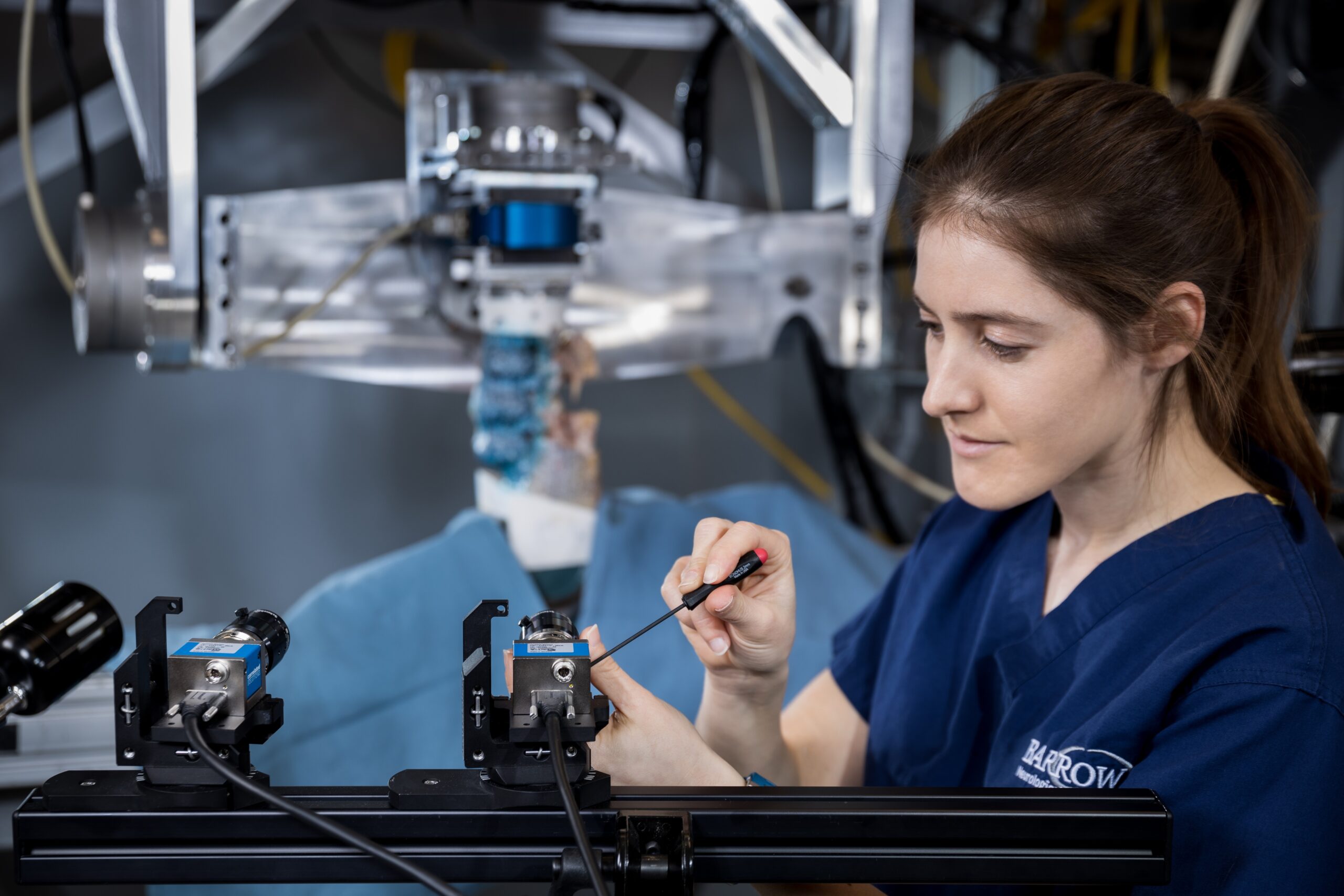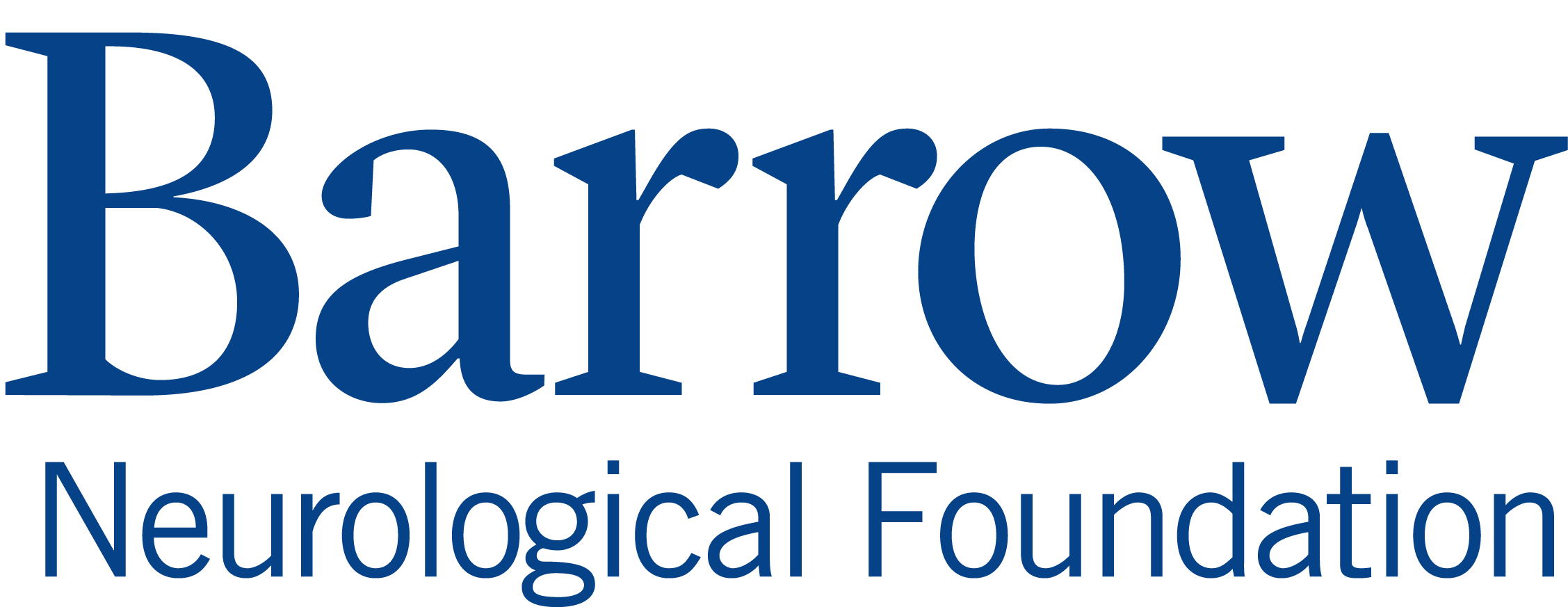
New Frontiers in Neuroscience

With your support, Barrow is transforming neuroscience
What do these have in common?
- A man with essential tremor undergoes an outpatient treatment using focused ultrasound, walking out of the hospital the same afternoon with his tremor nearly gone.
- A young man suffering from paralysis after a car accident takes his first steps again thanks to a sophisticated robotic exoskeleton.
- A patient with a genetic form of amyotrophic lateral sclerosis (ALS) receives a new medication and experiences a significant slowing in disease progression.
The answer: All three are cutting-edge treatments helping patients right now at Barrow Neurological Institute.
Ever since Barrow opened its doors in 1962, it has pursued leading-edge research that broadens the understanding of neurological processes and translates into new treatments, bringing hope to patients and families around the world. With support from generous Barrow Neurological Foundation donors, what began as a handful of researchers and clinical trials decades ago has blossomed into a modern research powerhouse. Today, dozens of Barrow scientists conduct groundbreaking research across the spectrum of neurological disorders, including ALS, Alzheimer’s disease, Parkinson’s disease, traumatic brain and spinal cord injuries, cerebrovascular diseases, stroke, and many others.
Barrow is one of only 25 sites in the nation to be part of the Network for Excellence in Neuroscience Clinical Trials (NeuroNEXT), which was created to improve access to clinical trials and facilitate faster answers to clinical questions. Barrow also is home to the Ivy Brain Tumor Center, the largest Phase 0 clinical trials program in the world for brain cancer.
However, this kind of transformative research comes with a hefty price tag. Thanks to Barrow Neurological Foundation, the fundraising arm of Barrow Neurological Institute, scientists receive funding to support high-risk, high-reward studies that otherwise would not be funded by federal agencies. These studies test novel concepts and have the potential to lead to breakthrough treatments and cures for the most devastating neurological diseases.
New Developments
One of those new treatments is an outpatient procedure to relieve the uncontrollable shaking of essential tremor (ET). At least 7 million people in the United States over 40 have ET, a movement disorder that causes involuntary shaking of the hands, making even the simplest daily tasks extremely difficult. Medications help to a degree, but there comes a point when they no longer help enough. Barrow patient James Kurtz knows the frustration of ET all too well. “[My hands] shook almost all the time, to the point where I could not even sign my name. I just had to have my wife do things for me,” he says. Kurtz lived with his tremor until he heard about a new treatment option at Barrow using focused ultrasound.
Through philanthropic support, Barrow was able to acquire this technology, which uses high-intensity sound waves to target an area deep in the brain. Guided by MRI, beams of focused ultrasound energy coming from different directions all converge at the precise spot in the thalamus that is causing the tremor. The sound waves generate heat, which ablates, or destroys, the targeted tissue. Because surgeons are not physically entering the brain, it’s an outpatient procedure. Amazingly, the results can be immediate. Most people experience significant relief of their tremor after just one treatment.
Kurtz had his procedure in March 2023. “I walked out of the hospital that afternoon, once again able to
Read more about James Kurtz’s story here.
do everything I need to do without the shaking,” Kurtz said. “I can write, I can use my computer …
anything I want to do.” Read more about James Kurtz’s story here.
A Commitment to Research
Like most areas of research, neuroscience research is usually incremental, though there are occasional leaps that generate excitement. “It can easily take a decade to go from a great idea and some early stage data to the approval stage for a new medication or treatment,” says Robert Bowser, PhD, Chief Scientific Officer at Barrow Neurological Institute. That speaks to the unwavering dedication of Barrow’s researchers and clinicians, as well as Barrow Neurological Foundation donors who support these efforts.
Whether it’s a single gene, a single biomarker, or a single treatment approach, neuroscience research can be a lifelong endeavor for the individual researcher. Dr. Bowser himself knows the feeling. He has a special research connection to a recently approved medication for ALS, which causes the deterioration of motor neurons, so patients lose their ability to swallow, talk, walk, and eventually, breathe. “Unlike other neurodegenerative diseases such as Alzheimer’s or Parkinson’s, where you can live for a decade or even two after diagnosis, ALS is a much more rapidly progressing disease, moving from diagnosis to death in only two to five years,” Dr. Bowser says.
Clinical research in the Gregory W. Fulton ALS and Neuromuscular Disease Center at Barrow focuses largely on biomarkers. Identifying biomarkers associated with ALS will allow for a personalized approach to treatment and help answer why some people develop ALS while others don’t, and why certain treatments are effective for some patients but not for others.
Fulton ALS Center Director Shafeeq Ladha, MD, and Barrow scientists played a critical role in studies that led to FDA approval of a new drug, tofersen, to treat a genetic form of ALS. It’s the first drug approved for a rare form of ALS linked to a mutation in a gene called SOD1. The mutated gene synthesizes an abnormal SOD1 protein, which is toxic to motor neuron cells. “[Tofersen] turns off the expression of the mutant gene, interfering with the synthesis of this abnormal protein,” Dr. Bowser says.
One of the biomarkers that was used to demonstrate the drug’s effectiveness is one Dr. Bowser has been researching for years, neurofilament light chain (NfL). Tofersen decreased levels of NfL, which correlated with clinical slowing of nerve damage and degeneration. Thus, it extends the period of time when ALS patients still experience a relatively high quality of life. “A small percentage of ALS patients have this genetic mutation, but if you can positively impact anyone with this disease, it’s a great thing. It’s a home run for patients who have this genetic form of ALS,” Dr. Bowser says.
A Foundation for Progress
Barrow Neurological Institute is a place where novel ideas are formed and discoveries are made that will have an impact on how neurological diseases are treated in the future. As a leading neuroscience Institute, its reputation stands tall, attracting talent from around the world who could do their work elsewhere but choose to come to Barrow.
“We are focused on bringing in clinicians and scientists who can work together in specific areas of expertise to tackle some of the most complex challenges out there,” says Dr. Bowser. “We start by asking, who are the patient populations that we’re seeing, what are the challenges to developing new and improved treatments and/or surgical approaches, and how can we match our clinicians who see the patients every day with the scientists and engineers who can do the work to propel the research forward?”
Robert Bowser, PhD
In addition to clinical and research expertise, it takes investment to keep everything moving forward. It’s Barrow Neurological Foundation’s mission to continue supporting the Institute’s groundbreaking research by cultivating major grants, endowments, and individual donations. The important role that philanthropy plays at Barrow cannot be understated. “If you’re working on a complex disease and you have an idea for a possible treatment approach that you wish to explore, it’s really hard to get funding,” Dr. Bowser says. “First you need to have a lot of the work already done and basic studies completed to demonstrate that the concept can translate into reality.”
The Foundation’s work to develop funding sources is critical to support this early research. Without it, progress would come to a halt. “The hope is that [financial support in the early stages] will help the investigators leapfrog up to the next stage and be competitive when applying for larger sources of funding, such as National Institutes of Health (NIH) grants,” says Dr. Bowser.
The Future of Neuroscience Research
The following are some of the exciting areas of research at Barrow right now that have the potential to yield the treatments of the future:
- Barrow researchers are developing preclinical models of brain aneurysms (weak spots along a blood vessel) and AVMs (abnormal tangles of blood vessels) to find more effective ways to stabilize them and prevent them from rupturing. One avenue they are investigating is a medication-based approach to preventing ruptures. Since aneurysm and AVM surgery is invasive, this could be lifesaving for patients whose risks associated with surgery are extremely high.
- Barrow researchers are working with gene-therapy approaches to target specific cell types in Parkinson’s, ALS, and other neurological diseases. One of these studies includes using gene therapy to deliver the protein ACMSD to the kynurenine metabolic pathway, which becomes dysfunctional in Parkinson’s. Scientists hypothesize that doing this will both reduce the production of harmful molecules and facilitate the production of a neuroprotective compound. ACMSD gene therapy represents a completely novel therapeutic modality in Parkinson’s. Moreover, data suggests that the same pathway may be altered in other neurological diseases as well, paving the way for expanded studies utilizing this approach.
- The Barrow Neuro-Rehabilitation Center is at the forefront of neuro-robotics, devices that mimic normal human movements and adapt to a patient’s specific abilities. One novel rehabilitation technology is called the robotic exoskeleton. “Unfortunately, we’re still not very far along on actually regenerating spinal nerves in patients with paralysis, but with this wearable external technology you can create a brain-computer connection in which the patient can think about moving a leg and it actually moves,” says Dr. Bowser. “It helps train the brain and muscles, allowing patients with spinal cord injury, stroke, or other neurological conditions to retrain their bodies to walk. It’s exciting work.”
As for the “final frontier” in neuroscience research, many questions remain unanswered, at least for now. “We might understand maybe 10% of how the brain and central nervous system really operate,” says Dr. Bowser. The brain is the most complex system in the known universe. To put that in perspective, the Milky Way Galaxy has hundreds of billions of stars, just a small fraction of the 100 trillion connections in our brain. But, like any other complicated machine, errors can arise. “We’re good at asking certain questions and trying various treatments for diseases, but we know less about the processes involved during the development [of neurological conditions] and how different regions of the brain connect and interact with one another,” says Dr. Bowser. “A lot of work remains to be done.”
None of this important work is possible without the support of generous donors who believe in Barrow’s mission of saving lives through innovative treatments and groundbreaking research. Barrow Neurological Institute is one of the top neurological research institutions in the country, and its scientists and clinicians are some of the best in the world. By supporting this work, Barrow Neurological Foundation is helping to ensure a brighter and healthier future.
Contact Us for the Latest Neuroscience Research
You can make the future happen! To support Barrow Neurological Institute’s groundbreaking research,
call us at (602) 406-3041 or go online to https://giveto.supportbarrow.org/donate.
